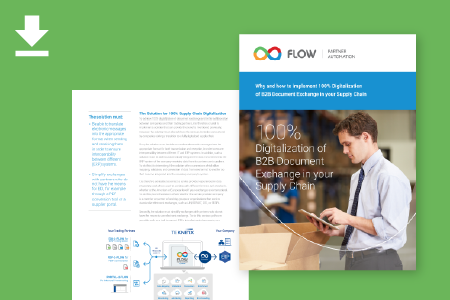There are countless ways in which this can be done, but we’re going to shine light on the supply chain, specifically when it comes to document exchange.
Maybe you’re a solo entrepreneur. Maybe you’re the CFO of a large corporation. What do the two have in common? You each want to make your company profitable. So, how do you do it? By keeping track of every single transactional (and related) document that flows in or out of your business. And, of course, much more—we’re not trying to downplay either role!
The point is, the business world revolves around the act of buying and selling, purchasing and supplying. This naturally involves a lot of back-and-forth communication between both parties and typically results in a sea of standard business documents (like purchase orders and invoices) in any number of formats, stored in any number of locations, delivered in any number of ways.
Let’s just say some methods are better (for the world, and for your business) than others.
Digitalization and Corporate Social Responsibility (CSR)
The need to demonstrate a genuine commitment to CSR certainly influences business decisions across the board. But it’s not often that you come across an initiative that covers more areas of interest than document exchange digitalization—especially one that simultaneously offers a sustainable solution for improving business process efficiency and meeting compliance-related needs now and in the future.
In the Netherlands, for example, the International Energy Agency is rapidly enforcing a new energy policy focused on cutting greenhouse emissions by 49% by 2030. Additionally, Dutch companies that have over 100 employees must lower their CO2 emissions (and report these statistics) within the next 4 years – effective January 1, 2023. This is an increasingly common trend across the world as more businesses are taking notice of their CO2 emissions and standards are adapting to ensure that companies are environmentally sustainable.
While there are no specific standards set in place in North America right now for decreasing carbon emissions, we can safely assume that there will be in the near future. According to an EY study, most CEOs believe that over the next five years, we will see significant steps to take environmental and social responsibility for the impact of their organization in the United States. And, right now more than ever, we are seeing large US-based corporations pledge to increase their environmental sustainability.
Digitalization and the Environment
One very obvious way to contribute to a better environment is to eliminate the use of paper, which is exactly what a digitalization solution does. Did you know that a single tree produces, on average, 10,000 sheets of paper? Any company knows all too well how quickly business documents can pile up. TIE Kinetix, for example, facilitates the exchange of more than 81 million documents each year via their FLOW Partner Automation platform—that’s over 10,000 trees saved on an annual basis.
With the elimination of paper also comes the elimination of printing. Toner, ink, and even printers themselves, require the use of harmful chemicals during the manufacturing process. After all, everything is made of plastic. Each toner cartridge emits roughly 3.2kg C02, and, due to their composition, both ink and toner cartridges take between 500 and 1,000 years to decompose. And even though 97% of each cartridge is recyclable, more than 50% still end up in landfills. That amounts to 300 million cartridges in the U.S. alone.
Speaking of the U.S., the Federal Reserve claims, “While consumers have rapidly transitioned from paper to digital transactions, businesses have lagged behind. A staggering 75% of the 25 billion business-to-business (B2B) invoices exchanged annually in the United States still require manual processing.” That quickly translate to this: There’s a lot of room for improvement. In evaluating their own environmental impact, companies are much more likely to realize the potential benefits of digitalization as opposed to digitization not only in relation to CSR but when it comes to improving their business strategy as a whole.
There’s More to Sustainability than Going Green
If you consider the more traditional solutions for document exchange—these are often around 50% digital—that still work with paper or heavily rely on an insecure email communication (or in many cases involve a combination of both of these things) we can start to see how there’s more to sustainability than going green.
Of course, using paper, toner, and ink cartridges is bad for the environment and doesn’t contribute to a company’s efforts to reduce their carbon footprint. But using paper also means that automation isn’t possible because a human will always need to be involved.
So that means that these solutions aren’t sustainable from an efficiency standpoint. The same goes for solutions that don’t necessarily involve paper but rely on unreliable data capture techniques like OCR (Optical Character Recognition – a technology that is used for recognizing text characters inside of PDF files and converting them into searchable and readable data) —because a human will always have to be involved in some capacity or another.
And when you consider the fact that 80% of cyber-attacks occur via the supply chain and that relying on insecure email to exchange transactional documents with business partners makes you vulnerable to these attacks, it’s easy to see why these 50% digital solutions aren’t sustainable from a security standpoint either. An EDI solution can enhance supply chain security.
We can also say with confidence that these solutions aren’t sustainable when it comes to compliance, such as the need to meet e-invoicing obligations in Europe, or the ability to adapt to different EDI standards in North America.
When you think about sustainability in a broader sense and connect it back to the top priorities that most businesses have, the need for a 100% digitalization solution like FLOW is clear.
Digitalization and the Workplace
The effects of paper go beyond the environment. With a tight labor market, hybrid working, full-time work-from-home situations, and, along with that, employees’ changing expectations, it’s important to adapt accordingly. If one thing is certain, paper plays no role here. It’s bad for accessibility, and it’s bad for morale.
A digitalization solution makes it easy to work from anywhere in the world and have secure access to the documents you need. Moreover, repetitive, manual-entry tasks are eliminated. This opens up the opportunity to give employees in, for example, the finance department, a greater sense of meaning in their work—happy employees are undeniably more productive than those that feel depleted at the end of the day. With this, companies are able to meet (and maybe even exceed) the expectations associated with a new generation of work as well as make themselves a more appealing option for attracting new talent.
Improve Security and Choose to Do Good
The effects of digitalization are far reaching, while the same can’t be said about digitization, or at least not to the same extent. On the surface, investing in a digitization solution may seem promising. There are, of course, some operational benefits, like reduced manual entry, but this can never result in the true automation of repetitive tasks, and it certainly won’t solve the paper problem.
So while digitization may be good for your company in the short term, remember this: Digitization is, and always will be, a temporary fix. Digitalization, on the other hand, is a long-term solution. It’s good for your company, it’s good for your employees, and it’s good for the world.




